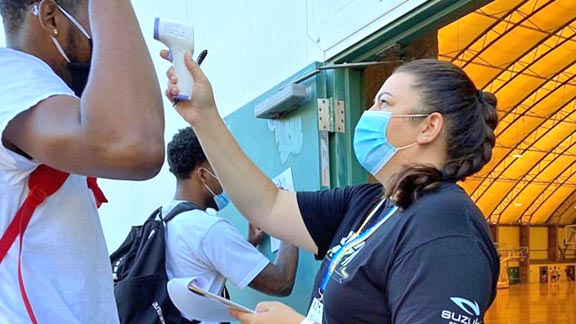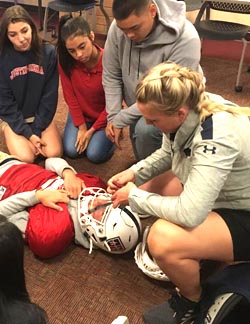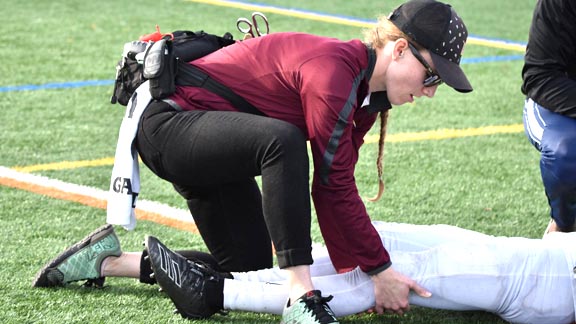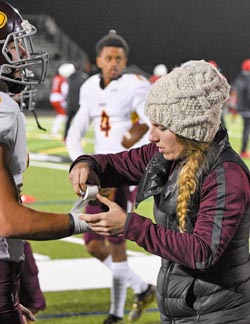
Jennifer Carranza, a certified athletic trainer at San Diego Miramar College, takes the temperature of a student athlete before he enters the gym at a high school in the San Diego area. Photo: California Athletic Trainers’ Association.
Taping ankles and wrists have long ago become more than what athletic trainers are known for at schools throughout the state. From concussions and now helping athletes and coaches deal with impacts of a global pandemic, trainers have become doubly important in recent years and months. So why is California the only state in the nation without a law requiring that these trainers be officially licensed?
We hope you enjoy this free post on CalHiSports.com. Please help us out today by becoming a member of our Gold Club so you can see all of our great content. We just did a Gold Club feature on the 40 Greatest Teams in State Baseball History and will have similar Gold Club posts coming up for boys hoops and girls hoops. All state football records also are now updated prior to start of the next season (whenever that turns out to be). For more on special offer to get signed up for $3.99 for one month, CLICK HERE.
Whenever high school sports eventually returns back to action within the state of California, potentially the most important role at your local high school may for someone who doesn’t even officially exist.
The role of a certified athletic trainer is one of the least understood and underappreciated parts of a successful athletic program and community. The hard work of these men and women could be the reason for schools to be as safe as possible during practices and will help with the possibility of competitions during the 2020-21 school year.
For many schools across California, the process of returning to athletic competition after the outbreak of the Coronavirus pandemic last March has been a journey into the true unknown. There’s no precedent set at any level, and even major sports leagues, in particular Major League Baseball and the National Basketball Association, have struggled to handle the return to professional sports because of the many complex challenges that COVID-19 presents.

Sarah Goble teaches her students during her Introduction to Sports Medicine class at Justin-Siena High School in Napa. Photo: Mindy Breslin.
At all levels, athletic trainers have been one of the driving forces, when it comes to the daunting task of setting up off-season workouts safely during this summer and for when athletics eventually returns.
“It won’t be normal,” said Sarah Goble, athletic trainer at Justin-Siena High in Napa. “I think we are likely facing shortened seasons, less travel, and possibly no fans in the stands. Ultimately, beyond caring for student-athletes, we now need to care for everyone in our community. We will follow the leadership of our public health department and get back to athletics as soon and as SAFELY as possible.”
Goble added: “I feel for these student-athletes who missed their spring season, and now are facing the possibility of missing more in athletics. I’ve often compared it to the student-athletes who sustain a season ending injury. COVID-19 is the season, even career-ending injury for a lot of our athletes all at once. It’s heartbreaking, and this time I can’t be there to fix them.”
Justin-Siena is one of those many schools that have turned to their certified athletic trainer during the pandemic. Goble is entering her 10th year as the full-time trainer for the Braves and has helped the school become a recognized NATA Safe School in each of her years at the private school. The Braves were the first school in the Napa Valley to start back up with offseason workouts during the summer.
“Our athletic department, including myself as the interpreter of the medical information, played a big role in us returning,” Goble said. “I believe having an athletic trainer on staff helps in these times to navigate the information being dissipated by multiple agencies and organizations. One of my roles in our return will be contact tracing in the event of an exposure to one of our student-athletes or staff. In addition, ensuring if we have a student-athlete diagnosed with COVID-19 that he or she receive proper care and testing post-illness.”
Justin-Siena alumni and current offensive line coach and assistant strength & conditioning coach Diano Pachote has seen the quality work of athletic trainers first hand, as the former workhorse running back and linebacker attributes some of his success on the field to his high school athletic trainer. Pachote helped power the Braves to a North Coast Section Division IV championship game win over San Marin of Novato during his junior campaign in 2012 under the watchful eye of 2004 Coach of the Year Rich Cotruvo. The 5-foot-8, 205-pound bruiser picked up 1,981 rushing yards from 204 carries for 21 touchdowns in 11 games during his senior year within the veer offense.
“Athletic training is far more than taping ankles and making sure water coolers are taken care of,” Pachote said. “It encompasses the entire health and well-being of an athlete, in the physical sense as well as emotionally. When an athlete has a major injury, they do not simply check in with their doctor once a week and follow some exercises on a piece of paper. Athletic trainers see their athletes every single day and check in with them, monitor their progress not only of their injured body part, but oftentimes their fractured mindset that comes with being stripped of your passion to play. Fortunately, at the high school level, I did not sustain any serious injuries, but nearly every day I found myself in her [Goble’s] training room doing rehab for the minor aches and pains that did arise. Without her help and guidance, I don’t think I would’ve been able to be on the field nearly as much, or been as productive as I was.”
Another school in Northern California that has had a clear message on restarting sports during COVID-19 has been resurgent Piner High of Santa Rosa. The Prospectors hired athletic trainer Chelsea Matthew in 2018 and one year later offered her the Co-Athletic Director position. Matthew still holds dual roles within the public school an hour north of the Golden Gate.
“I definitely have a unique perspective as I have a handle on our league and state bylaws as an athletic director, but view both those regulations and the county health requirements through my healthcare lens,” Matthew said. “I’m fortunate to be working alongside great leadership at Piner High School and within our district who seem to be taking into account our perspectives. ATs are built for uncertainty and change. We often cannot control how practices and games go and have to adapt and respond when things go sideways. We’re uniquely poised to be resources for developing plans to return to athletics specifically because of our adaptability, depth of knowledge on infection control, organization, and knowledge of practice requirements.”

Chelsea Matthew takes care of a Piner High School athlete during role as athletic trainer. She is also Co-Athletic Director at the school. Photo: Mindy Breslin.
California not progressive on athletic trainers’ issue
The state of California is currently the only state in the nation that does not require regulations on athletic trainers as a job position, with a wide majority of other states requiring a full license as a requirement for employment. A recent study from the Journal of Athletic Training from the 2018-2019 sports season in California saw that 47 percent of schools didn’t have an athletic trainer at all on campus. Of that 53 percent of schools that do have an athletic trainer, one in six athletic trainers aren’t certified.
“It is far past due,” Matthew said. “I cannot believe California is still the only state to not regulate certified athletic trainers, when this state has historically been very progressive. I’ve worked in two different states where licensure is the norm, where all schools in our leagues have full-time certified athletic trainers. I could trust that if my athletes traveled to another school, they would have access to athletic training services should they need it.”
Matthew added: “There was a continuity of care that I took for granted, which is overall not present in California. Working as a certified athletic trainer in Sonoma County has been eye-opening, 77 percent of high schools in Sonoma County do not provide their athletes with access to a certified athletic trainer. The schools without athletic trainers rely on other personnel to manage athletic healthcare.”
Marin County, the county just south of Sonoma County, has improved vastly over the past decade when it comes to athletic trainers, with the small county being a shining example of schools valuing athletic trainers.

Athletic trainer Chelsea Matthew takes care of Piner’s Jake Herman in 2019 football game when Prospectors played Montgomery (Santa Rosa). Photo: Mindy Breslin.
“All of the Marin schools will have an athletic trainer of some kind this upcoming year, be it full time or part time,” Marin Academy’s (San Rafael) Athletic Trainer Aaron Gill said. “Back when I started at Marin Academy in 2009, there were only about four of us. It is nice to see that growth.”
For some school districts, an athletic trainer is seen as an extra benefit for athletics who is one of the first positions to find the chopping block when it comes to the hard hit budgets because of COVID-19. Other schools have taken the potentially dangerous route of hiring part-time uncertified athletic trainers to help with their budgets.
“Having a full-time athletic trainer is not a luxury, but a necessity,” Pachote said. “During my high school and collegiate career, I was fortunate enough to have at least one athletic trainer available to my team for seven of those eight seasons.”
Goble joined the Justin-Siena staff in 2011 and her impact was felt immediately.
“The year prior I was a freshman and new to football,” Pachote said. “I sustained a couple of sprained wrists and other minor injuries. Enter Sarah, with minimal space to work, she jam-packed her athletic training room with all of the essentials; training tables, STIM and TENS units, endless bands and small increment weights, and of course lots of tape. Suddenly, every issue I was having with my body seemingly had an answer in the form of rehabilitation programs, manual therapy, or generally great and insightful information on anatomy and body mechanics.”
Some athletic trainers haven’t been as lucky when it comes to facing the budget shortfalls that are besieging the country.
Sam Arredondo was one of those unfortunate few, with the fast rising talent caught up in the unfortunate situation. Arredondo was named the interim head football athletic trainer at Washington State University at the age of 26 in 2019, but resigned after the season to take a job closer to home. He grew up in the Central Valley and took a job in January working at Sierra Pacific High in Hanford employed through Adventist Health. Just a few months after being hired, Arredondo was put on furlough and was recently laid off completely because of budget shortfalls caused by COVID-19.
“Athletic trainers being hired directly through a school district is vital for both the athletic rainer and the school district.,” Arredondo said. “It saves the athletic trainer from being laid off through a hospital system or other entity that may be providing some of the athletic trainer’s salary. It also lowers the risk the school districts take on and in some cases can lower their insurance premiums for having a trainer present.”
Arredondo added: “Districts who directly hire athletic trainers can also see the benefit through emergency action plans written by the trainer to follow in the event of an emergency at a school function. We can take care of students and spectators and initiate life-saving actions. High schools can also see benefits such as cost containment and student success by offering healthcare assistance at the school which saves the kids from having to leave school and parents time and money by providing services they need right there at the school.”
Sonoma County hasn’t had the best track record when it comes to the total number of athletic trainers within their schools, but the Santa Rosa City Schools district has been leading the charge for the county.
“Thankfully, Santa Rosa City Schools have been very supportive of us athletic trainers during this time, when across the country many schools are either furloughing their athletic trainers or letting the positions go all together,” Matthew said. “There’s five of us, one for each high school in the district, and we spent most of May working on COVID-19 protocols for returning to athletics in the summer. I, along with my coworkers Kevin Bower, from Elsie Allen High School (Santa Rosa), and Mercedes Zipperle from Santa Rosa High School, were all on the Santa Rosa City Schools return-to-school planning subcommittees.
“We were able to provide our perspective and advocate for the safety of our athletes and our student community when we do return to school,” Matthew continued. “I miss my athletes and coaches terribly, but have bulked up my presence on my social media platforms. I’ve been involved in a couple of my teams’ Google Classrooms, sharing workout and recovery tips and mental health resources. I’ve also been brainstorming and advocating to the district admin for how us athletic trainers can still be involved within our school community should athletics be postponed or greatly reduced this upcoming school year.”
Number to Know: AB1665
This issue of California not requiring fully licensed athletic trainers has been a passionate cause for many of the profession and potentially will be solved by California State legislative bill AB1665, a proposal by Assemblymember Rob Bonta of D-Oakland. The proposed bill would enact the Athletic Training Practice Act. It would prohibit a person from acting as an Athletic Trainer if they do not have a license and define what is an Athletic Trainer and what isn’t.

“At this point in time, California is the only state that does not regulate athletic trainers through licensure or registration,” Goble said. “What this means is in the cases of schools or club teams that employ a person who is not a certified athletic trainer there is nothing we can do to reprimand that individual for misrepresenting themselves. Schools and clubs will hire these individuals because they are cheaper, meaning in essence they don’t value their athlete’s health and safety enough to hire a certified athletic trainer. A person who does not meet these requirements poses a danger to athletes under their care. I have unfortunately seen my own student-athletes put in danger when traveling to a school who employs a person who is not a certified athletic trainer. Luckily for this student athlete, the lack of care they received for a concussion was recognized by their coach who held them from play until seen by me on campus the next day. The student athlete did have a concussion and could have been further injured if they had returned to play.”
“AB1665 is VITAL to the profession in California,” Arredondo said. “It would allow parents to know that anybody who is calling themselves an athletic trainer has undergone the rigorous education to provide medical care for their child. In today’s world with the pandemic, licensure of our profession would mean that there are even more recognized healthcare professionals to assist with the pandemic.”
Arredondo added: “Athletic trainers have already been given duties outside of our normal scope to assist where we can…no licensure makes that impossible for us now. Other states such as Pennsylvania even enacted an executive order to expand the scope of athletic trainers to supplement the front lines healthcare providers to directly help with COVID-19. That can’t be done without licensure here in California which means there are some athletic trainers that haven’t been able to assist much in this situation. AB1665 would give California more healthcare providers, an extreme need in a global pandemic.”
Whenever student athletes are finally able to return to the athletic field for good, it will look different, without traditions many people have looked forward to for years.
“Be it players, parents, coaches, staff, media and everyone in between, this has the potential to take more time than we all can imagine,” Arredondo said. “There will be heavy restrictions, but high school sports will return eventually. It will be a glorious day when it does.
“There’s a lot of additional safety precautions that will have to be put in place and I believe we athletic trainers will be instrumental in the how of it,” Matthew said. “We will have to rely heavily on our coaches, parents, athletes, administration, and the greater community to implement and enforce these new safety measures. We have to realize that if we want sports back, we all need to do our part to make it a reality. We also need to be flexible in the implementation and timeline as this is such a fluid situation.”
Matthew and the other athletic trainers contacted for this article all know how important athletics can be in the social-emotional development of high schoolers.
“It leaves a gaping hole in their lives,” she said. “However, we need to be prepared that it might not look normal’ for a while. If the greater community accepts that, along with the changes needed to move forward to have high school athletics, it’ll be a lot easier. I absolutely grieve for the seasons lost and what sports looked like pre-COVID. I know I have. But when we finally get back to some sort of activity, we need everyone to do their part to fully follow the safety measures.”
And who’s best equipped in all of these schools in the state to know all of the safety measures? Your friendly, neighborhood athletic trainer.
Daniel Poulter is a special Northern California correspondent for Cal-Hi Sports and does high school sports reporting for other media outlets, primarily the Napa Register. Follow him on twitter @DanielJPoulter.
Mark Tennis is the co-founder and publisher of CalHiSports.com. He can be reached at markjtennis@gmail.com. Don’t forget to follow Mark on the Cal-Hi Sports Twitter handle: @CalHiSports




